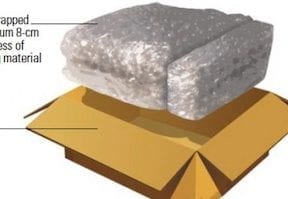The United States Postal Service is a popular shipping solution for American ecommerce businesses. It stacks up well against other carriers in several situations.
The USPS may be particularly effective when you need to ship (a) small, heavy items, (b) lightweight, bulky products, or (c) shipments destined for post office box addresses, including APO (Army Post Office), FPO (Fleet Post Office, for ships), or when associated pick-up fees impact profits.
Small, Heavy Items
The USPS pioneered flat rate shipping. “If it fits, it ships.”
While other carriers have added flat rate options, the USPS flat rate Priority Mail boxes are still one of the best solutions for businesses sending small, but heavy, products.
Imagine you wanted to purchase a Captains of Crush gripper set to improve your grip strength. The set of three grippers is relatively heavy — about four pounds. But will fit inside of a USPS Priority Mail 2-Day Small Flat Rate Box.

Sold in a set of three, these grip trainers are relatively small and heavy — just about perfect for a flat rate box.
The ecommerce store selling your gripper set could save more than $3 on shipping if it used a small USPS Priority Mail Flat Rate box, based on published shipping rates on October 3, 2017. Here is an example, shipping from area code 83607 (Caldwell, Idaho) to 21205 (Baltimore, Maryland).
| Captains of Crush Gripper Set from 83607 to 21205 | ||
|---|---|---|
| USPS Priority Mail Small Flat Rate Box | $7.15 | 2 Days |
| FedEx Express Saver One Rate Small Box | $10.75 | 3 Days |
| UPS Ground | $16.60 | 4 Days |
While a store could compare a number of other services, the example shows how USPS flat rate would save money on shipping.
The key in the example is that these grippers are relatively heavy at about four pounds, but they don’t take up much space, which is when flat rate shipping works best.
Lightweight Products
Dimensional weight pricing has been around for a few years, but how it works may not be clear to every ecommerce shipper.
Essentially, dimensional weight pricing means that a shipper will either be charged for the actual weight of a package or for the average weight of a similarly sized package, whichever is greater.
While all major carriers in the United States have some form of dimensional weight pricing, the USPS only applies it to packages larger than a cubic foot and headed to zones five through nine.
What’s more, the USPS uses a different volumetric divisor (typically 194 for the USPS versus 166 for some other carriers), which can be beneficial to shippers.

When it does apply dimensional weight, the USPS calculates it differently, in a way that is favorable to shippers.
If a business ships very lightweight products, dimensional weight can significantly increase shipping costs among all carriers. But the USPS may be less expensive.
Post Office Boxes; Military Addresses
The USPS is the primary way to ship packages to military or diplomatic addresses or for shipping to a post office box.
Other carriers “can” ship to these APO, FPO, or post office box addresses using a last mile service. For example, you could ship via FedEx SmartPost. FedEx will pick up the package transport it to the USPS and let the postal service deliver it to the military address or post office box.
You can compare rates to learn if a last mile service makes sense. But know that in one fashion or another, the USPS will be involved.
Free Pick-up
Small ecommerce operations with a low volume of packages shipped may save $670 or more a year in daily pick-up fees with the USPS.
At the time of writing, the USPS makes free, regular pick-ups at essentially every address in the United States, six days a week — although it does charge for on-demand pick-ups.
Even if you are running an ecommerce business out of your garage, you can put packages in an oversized mailbox and expect free pick-ups.
Other carriers may charge low-volume shippers weekly or daily pick-up fees. For example, UPS charges $12.90 per week for daily pick-up if your business spends more than $75 per week on shipping. FedEx charges $13 for a similar service.
Carrier Selection
In 2016, the USPS processed about $17 billion in package deliveries, moving something like 5.1 billion shipments, according to its 2016 annual report.
Handling more than 16.5 million packages a day, Monday through Saturday, certainly puts the USPS among the largest carriers. But it is not the only carrier.
There are many shipping options and many shipping services to consider. When you’re selecting a carrier for your ecommerce business, consider the size and weight of the packages you ship and the locations you ship to most. Then compare carriers to identify the best combination of price, value, and service for your business.
It may also make sense to look at shipping rates more generally, rather than on each and every order, since there is often a benefit to increasing shipping volume with a single carrier.




